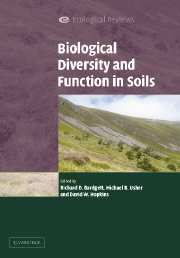Book contents
- Frontmatter
- Contents
- List of contributors
- Preface
- Acknowledgements
- PART I Introduction
- PART II The soil environment
- PART III Patterns and drivers of soil biodiversity
- PART IV Consequences of soil biodiversity
- 10 Microbial community composition and soil nitrogen cycling: is there really a connection?
- 11 Biodiversity of saprotrophic fungi in relation to their function: do fungi obey the rules?
- 12 Is diversity of mycorrhizal fungi important for ecosystem functioning?
- 13 Trophic structure and functional redundancy in soil communities
- 14 Plant–soil feedback and soil biodiversity affect the composition of plant communities
- 15 Response of the soil bacterial community to perturbation
- PART V Applications of soil biodiversity
- PART VI Conclusion
- Index
- References
12 - Is diversity of mycorrhizal fungi important for ecosystem functioning?
Published online by Cambridge University Press: 17 September 2009
- Frontmatter
- Contents
- List of contributors
- Preface
- Acknowledgements
- PART I Introduction
- PART II The soil environment
- PART III Patterns and drivers of soil biodiversity
- PART IV Consequences of soil biodiversity
- 10 Microbial community composition and soil nitrogen cycling: is there really a connection?
- 11 Biodiversity of saprotrophic fungi in relation to their function: do fungi obey the rules?
- 12 Is diversity of mycorrhizal fungi important for ecosystem functioning?
- 13 Trophic structure and functional redundancy in soil communities
- 14 Plant–soil feedback and soil biodiversity affect the composition of plant communities
- 15 Response of the soil bacterial community to perturbation
- PART V Applications of soil biodiversity
- PART VI Conclusion
- Index
- References
Summary
SUMMARY
Globally accelerating rates of species loss make it imperative that relationships between biodiversity and ecosystem function are analysed, yet resolution of these interactions has presented one of the most intractable challenges in ecological research.
Because biodiversity in soil is considerably greater than that above ground, and the identities and functions of many soil microorganisms are uncharacterised, the difficulties involved in establishing diversity–function relationships in the below-ground environment are compounded.
For some keystone groups of soil microorganisms, prominent among which are the mycorrhizal fungi, diversity–function relationships are starting to be elucidated. Mycorrhizal symbionts are present in virtually all terrestrial ecosystems where they are major components of the soil microbial biomass.
There is increasing evidence that mycorrhizal diversity is of central importance in agro-ecosystem functioning, and that intensification of agriculture and forestry, combined with air and soil pollution, is reducing their diversity and compromising their functioning. Two lines of evidence support the case that mycorrhizal diversity is of major functional significance, namely (1) that mycorrhizal associations are multi-functional and exhibit complementarity, assisting plants in nutrient acquisition, mediating carbon transfer between plants and protecting their roots from pathogens; and (2) that on the basis of emerging evidence of a combination of high specificity and dependency in many mycorrhizal associations, especially those involving myco-heterotrophic plants, it is hypothesised that the extent of functional ‘redundancy’ is low.
Introduction
It is now recognised that the accelerating rates of species extinctions, which are arising from progressive intensification of land use, pose a global threat to biodiversity (Pimm et al. 1995).
- Type
- Chapter
- Information
- Biological Diversity and Function in Soils , pp. 216 - 235Publisher: Cambridge University PressPrint publication year: 2005
References
- 4
- Cited by



